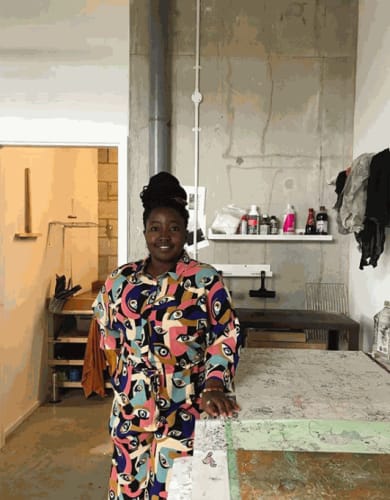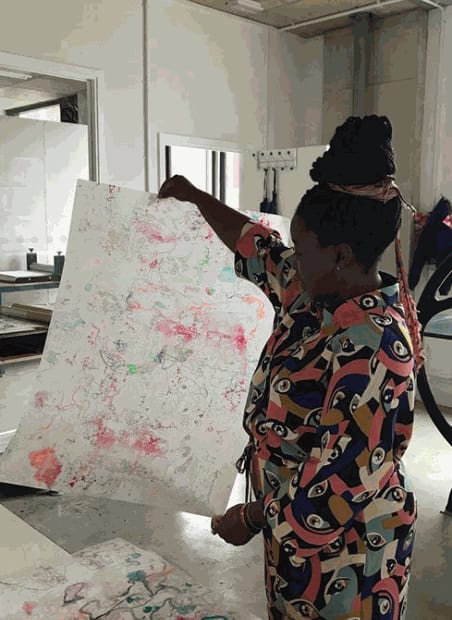Tanaka Mazivanhanga
@tanaka.archiprints
I’m so excited to be collaborating with the incredible @woolwichcontemporaryprintfair this year!!
Tanaka Mazivanhanga is part of the Woolwich Contemporary Editions programme, and was commissioned to create large-scale installation Floating Islands, at the 2019 fair.
The Zimbabwe-born artist focuses on challenging perceptions of space by presenting her memories of transient surfaces in an unfamiliar way, drawing out the curious in the everyday.
-
INTERVIEW
Tanaka, where are you answering these questions from?
I’m writing from Bainbridge Print Studios in Croydon where my studio is based.
How would you describe your work in just three words Tanaka?
Preservation, memory of space, mapping
Tell me a bit about your artist story - How were you trained? How did you get to where you are now?
I initially wanted to be an architect, so after being advised after secondary school to do a foundation diploma to further my skillset I specialised in 3D and printmaking at Havering College. I then continued my studies at Kingston School of Art and undertook a BA in Architecture. My love for printmaking was re-introduced to me in my final year at university as a means to experiment with different methods of visually representing my ideas. After l graduating, it became evident that architecture was not for me, and l wanted to explore and experiment with print. The next three years were spent in the Kingston School of Art print room experimenting with different techniques, and it was during that time l made the decision to apply for an MA. UAL: Camberwell was highly recommended for Printmaking, and l applied. My portfolio included experimental prints and some work from my BA. For a couple of months on the course,it was challenging for me to transition from being an architecture student to an artist/printmaker, as the course was quite independent. However, having had great tutors who challenged my ideas by asking difficult questions, encouraged my creativity, and assisted in refining or developing my ideas. My graduating show was awarded the Bainbridge Print Studios Studio award and selected for the Clifford Chance Postgraduate Printmaking: A Survey Exhibition. After graduating, l felt more confident to apply for some open calls and had the opportunity to exhibit at Woolwich Print Fair Contemporary 2019, where I was then awarded the East London Printmakers award and had the opportunity to take part in the site-specific installation commission - Islands, 2019. Currently, l am working on my practice, learning different techniques, and l have my desk space at Bainbridge Print Studios - Croydon.
What was the first artwork you remember creating yourself, and what was your earliest memory surrounding art?
The first artwork l recall making was a 3D mixed medium collage piece and a textile material African mask for my art and textile classes. The earliest memory surrounding art would have been around that time when we were taken on school trips to museums, and remember seeing Robert Rauschenberg and been fascinated by his pieces. I was interested in the composition and use of colour in his collage pieces.
How has your work evolved?
My work has evolved in several ways in my ongoing experimentation with the surface and colour. Recently, l have become interested in exploring different ways of challenging and building up the surface of the paper. My use of materials, collage, and stitching aims to capture the layered and shifting nature of the urban landscape, especially where the different materials overlap. My approach to working has become less restrictive, in the sense l don't plan anything, l let the process take control. I am not sure what the outcome is until l start, this is both liberating and challenging at the same time, but l embrace the uncertainty. My object making palette is now not only limited to casts, but now includes textile, carpet, and clay objects.
What are you working on currently?
I am working on an ongoing series called Tsoka Hadzina Maziso (Feet don’t have eyes). Alongside this, l am working on a series of prints and collages based on my visit to Ghana earlier in the year.
-
I love your ability to draw out the details in the often overlooked or forgotten every day! What are the themes and messages behind your work?
It’s about taking the viewer on a journey of discovery of everyday spaces, surfaces, and the forgotten relics of the urban landscape. I aim to evoke the viewers curiosity through the exploration of layering on the surface, which encourages the practice of looking. Further evoking them to interact with their surroundings and those around them. My object pieces, reflect on the need for physical and tangible objects other than simply for the exploration of materiality. They comment on the notion of disregard for physical things and objects, society’s relationship and dependency on technology, and lack of human interaction. We live in a fleeting society; there is increasingly less physical evidence of our existence and memories.
Could you select a piece of your work and tell me a bit about it?
The piece of work l would like to discuss is the Utopia series 2017-2019, a forty-five metre drawing which initially started as a side project documenting my progress. I exhibited it in a group show with fellow peers, and seeing it in its entirety, allowed me to critically assess it and reflect on its successes and failures. Upon this reflection, I decided to turn the drawing into a continuous and evolving piece - Utopia 2, 2018-2019. Utopia 2 combined different mono-printing techniques that to explored depth and layering through lines and colours through the materials I used. The use of transparent paper, captured a sense of depth, of various worlds and dimensions. The colour appears and disappears, flattening, and deepening spaces. Having showed the piece at my final graduate show it allowed me to be more playful with how I presented in effect evoking curiosity and interaction from the viewer, which then inspired the site-specific installation piece Islands, 2019 for Woolwich Contemporary Print Fair.
Tanaka who are your favourite historical female artists?
Frida Kahlo
Dora Marr
Louise Bourgeois
Helen Bucher
And who are your favourite current practicing female artists and their instagram handles?
Billie Zangewa
Virginia Chihota
Rachel Whiteread
Tschabalala Self @tschabalalaself
Kara Walker @kara_walker_official
Ruby Onyinyechi Amanze @ruby_oyinyechi_amanze
Bea Bonafini @beabonafini
Alice Irwin @alice.irwin_
Adele Supreme @adelesupreme
Wura-Natasha Ogunji @wuraogunji
Lynette Yiadom-Boakye @lynetteyiadomboakye
Fungai Marima @fungaimarima
Giovanna Petrocchi @giopetrocchi
Lilliana A. Romero @lilophilia
Sherrie-Leigh Jones @sherrieleighjonesart
Tiffanie Delune @tiffaniedelune
Victoria Ahrens @victoria.ahrens
Ellie Hayward @ellie_hayward
Zanele Muholi @muholizanele
Lubaina Himid @lubainapics
Ingrid Calame @ingridcalame
Joana Choumali @joana_choumali
Jessica Rankin @j_ss_c_r_nk_n
Njideka Akunyili Crosby @njidekaakunyilicrosby
Lujan Perez @lujanperez
@Lydia_k_baker_arts
Deborah Roberts @rdeborah191
Katherine Jones @katherinejones_pp
Antonia Showering @antoniashowering
Anna Perach @anna_perach
@elena_gileva_ceramics
Ghada Amer @ghadaamer
Portia Zvavahera @zvavaheraportia
Phoebe Boswell @phoebe.boswell
Lilia Luganskaia @lilialand




